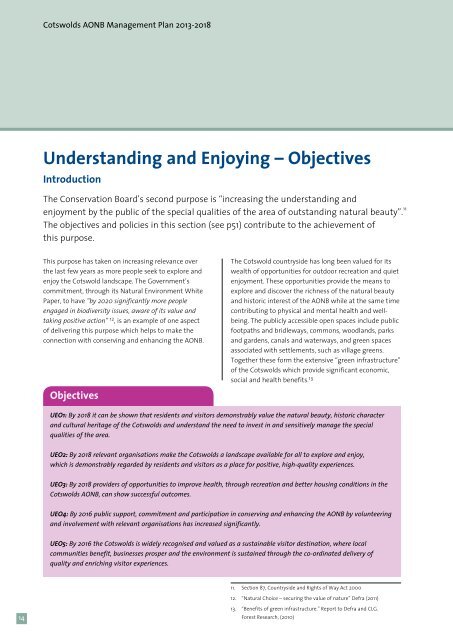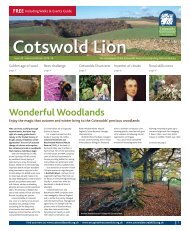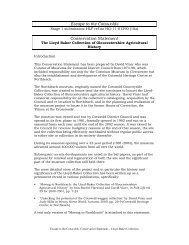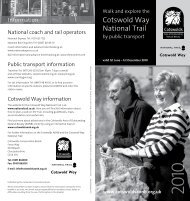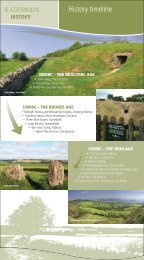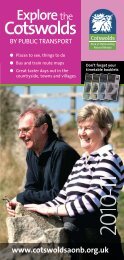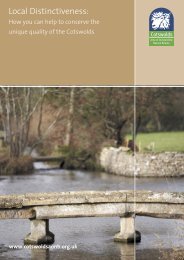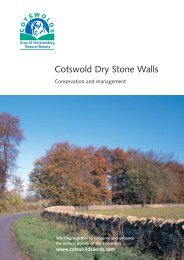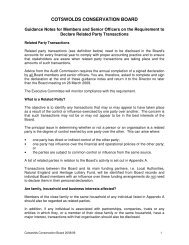Introduction - Cotswolds Area of Outstanding Natural Beauty
Introduction - Cotswolds Area of Outstanding Natural Beauty
Introduction - Cotswolds Area of Outstanding Natural Beauty
You also want an ePaper? Increase the reach of your titles
YUMPU automatically turns print PDFs into web optimized ePapers that Google loves.
<strong>Cotswolds</strong> AONB Management Plan 2013-2018<br />
Understanding and Enjoying – Objectives<br />
<strong>Introduction</strong><br />
The Conservation Board’s second purpose is “increasing the understanding and<br />
enjoyment by the public <strong>of</strong> the special qualities <strong>of</strong> the area <strong>of</strong> outstanding natural beauty”. 11<br />
The objectives and policies in this section (see p51) contribute to the achievement <strong>of</strong><br />
this purpose.<br />
This purpose has taken on increasing relevance over<br />
the last few years as more people seek to explore and<br />
enjoy the Cotswold landscape. The Government’s<br />
commitment, through its <strong>Natural</strong> Environment White<br />
Paper, to have “by 2020 significantly more people<br />
engaged in biodiversity issues, aware <strong>of</strong> its value and<br />
taking positive action” 12 , is an example <strong>of</strong> one aspect<br />
<strong>of</strong> delivering this purpose which helps to make the<br />
connection with conserving and enhancing the AONB.<br />
Objectives<br />
The Cotswold countryside has long been valued for its<br />
wealth <strong>of</strong> opportunities for outdoor recreation and quiet<br />
enjoyment. These opportunities provide the means to<br />
explore and discover the richness <strong>of</strong> the natural beauty<br />
and historic interest <strong>of</strong> the AONB while at the same time<br />
contributing to physical and mental health and wellbeing.<br />
The publicly accessible open spaces include public<br />
footpaths and bridleways, commons, woodlands, parks<br />
and gardens, canals and waterways, and green spaces<br />
associated with settlements, such as village greens.<br />
Together these form the extensive “green infrastructure”<br />
<strong>of</strong> the <strong>Cotswolds</strong> which provide significant economic,<br />
social and health benefits. 13<br />
UEO1: By 2018 it can be shown that residents and visitors demonstrably value the natural beauty, historic character<br />
and cultural heritage <strong>of</strong> the <strong>Cotswolds</strong> and understand the need to invest in and sensitively manage the special<br />
qualities <strong>of</strong> the area.<br />
UEO2: By 2018 relevant organisations make the <strong>Cotswolds</strong> a landscape available for all to explore and enjoy,<br />
which is demonstrably regarded by residents and visitors as a place for positive, high-quality experiences.<br />
UEO3: By 2018 providers <strong>of</strong> opportunities to improve health, through recreation and better housing conditions in the<br />
<strong>Cotswolds</strong> AONB, can show successful outcomes.<br />
UEO4: By 2016 public support, commitment and participation in conserving and enhancing the AONB by volunteering<br />
and involvement with relevant organisations has increased significantly.<br />
UEO5: By 2016 the <strong>Cotswolds</strong> is widely recognised and valued as a sustainable visitor destination, where local<br />
communities benefit, businesses prosper and the environment is sustained through the co-ordinated delivery <strong>of</strong><br />
quality and enriching visitor experiences.<br />
11. Section 87, Countryside and Rights <strong>of</strong> Way Act 2000<br />
12. “<strong>Natural</strong> Choice – securing the value <strong>of</strong> nature” Defra (2011)<br />
14<br />
13. “Benefits <strong>of</strong> green infrastructure.” Report to Defra and CLG.<br />
Forest Research, (2010)


